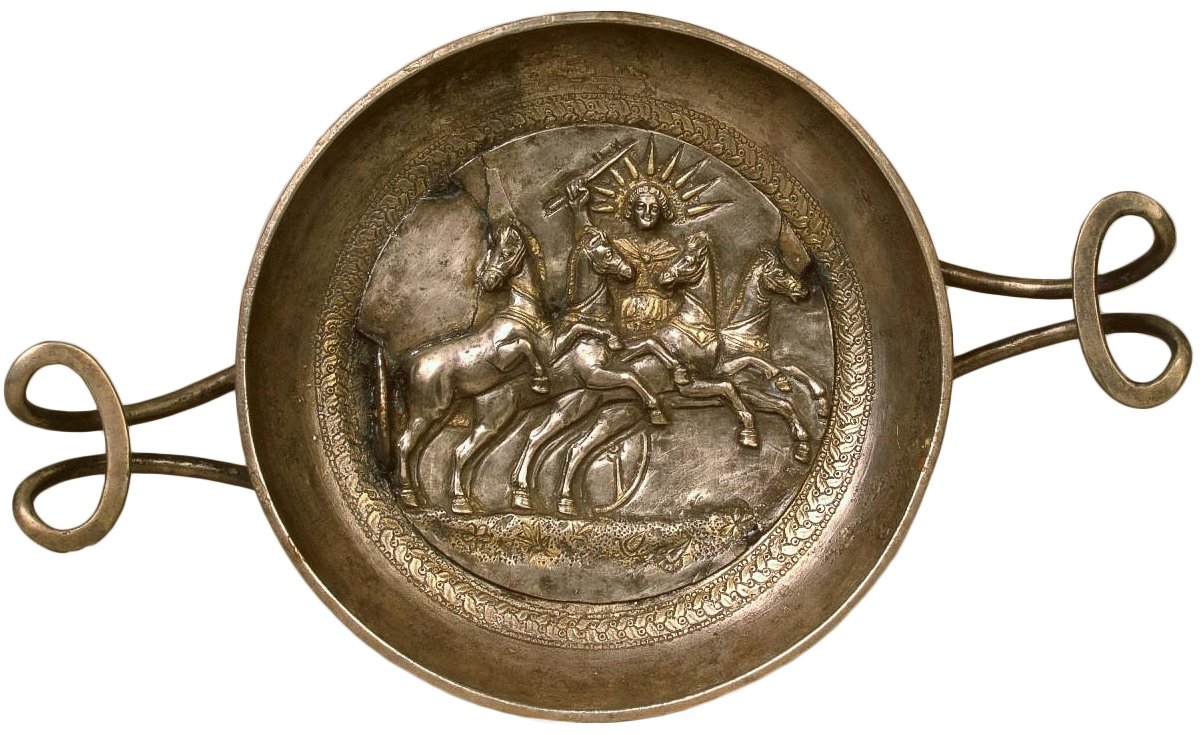SOL INVICTUS
Leave it to Rei Kawakubo to make a modernized punk version of a solar crown for her Spring 2013 Collection for Comme des Garçons Homme, drawing radical comparisons to those worn by Alexander the Great, Ptolemy III and Roman Emperors Augustus, Nero and Constantine to name a few...
Antoninianus coin depicting a crowned Emperor Postumus, a Roman commander of Batavian origin who ruled as Emperor of the splinter state of the Roman Empire known in contemporary times as the Gallic Empire • Circa 260-269 A.D. • Image courtesy of Heritage Auctions
“To the hard hitting back beat of heavy metal music from the likes of Black Sabbath and Bad Brains, designer Rei Kawakubo gave the world a Comme des Garçons show that was hard core but with a soft heart. Models, their hair tinted florescent orange and pushed back with metal studded headbands, tromped down a catwalk covered in dismantled scaffolding...“ • NowFashion
A radiant or radiate crown, also known as a solar crown, sun crown, Eastern crown, or tyrant's crown, is a crown, wreath, diadem, or other headgear symbolizing the sun, or more generally, powers associated with the sun. In Ptolemaic Egypt the solar crown, associated with the sun god Helios, appeared in art from the mid-2nd century BC onward. Helios, according to Greek mythology, drove a golden chariot which brought the Sun across the skies each day from the east to the west, while at night he did the return journey in leisurely fashion lounging in a golden cup. The first ruler of Egypt shown wearing this version of a solar crown was Ptolemy III Euergetes. In the Roman Empire, the solar crown was worn by Roman emperors influenced by radiate depictions of Alexander the Great as well as the cult of Sol Invictus, or "Unconquered Sun", which was long considered to be the official sun god of the later Roman Empire. Although Augustus is shown wearing one in a posthumous coin, after his deification, and Nero on at least one coin while he was alive, it only became common on coins in the 3rd century. Notably, the solar crown worn by Constantine, the first emperor to convert to Christianity, was reinterpreted as representing the "Holy Nails".
Black Leather Studded Headband • Spring / Summer 2013 Collection • Rei Kawakubo for Comme des Garçons Homme
Red-figured clay dish featuring a crowned Helios guiding his quadriga chariot across a starry sky • Circa 320 B.C. • Hellenistic Period • Canusium • Musée du Louvre, Paris
Gold octadrachm posthumously featuring a deified Ptolemy III Euergetes wearing a solar crown • Circa 221 – 205 B.C. • Ptolemaic Kingdom of Egypt • Kunsthistorisches Museum, Vienna
Cameo of a deified Emperor Augustus (Octavian) wearing the rayed crown of the sun god • First Century A.D. • Roman Empire • Römisch-Germanisches Museum, Cologne
Black Leather Studded Headband • Spring / Summer 2013 Collection • Rei Kawakubo for Comme des Garçons Homme
Gold octadrachm posthumously featuring a deified Ptolemy III Euergetes wearing a solar crown • Circa 221 – 205 B.C. • Ptolemaic Kingdom of Egypt • Image courtesy of Gallica Bibliothèque Nationale de France
Black Leather Studded Headband • Spring / Summer 2013 Collection • Rei Kawakubo for Comme des Garçons Homme
Limestone relief depicting Helios driving his celestial quadriga chariot • Musées Royaux des Beaux-Arts de Belgique, Brussels
Antoninianus silver coin depicting Emperor Trajan Decius wearing a radiant crown • Circa 249 – 251 A.D. • Roman Empire • Private Collection
Architrave relief depicting Helios riding his quadriga chariot • Temple of Athena at Troy • Circa 300 - 280 B.C. • Altes Museum : Staatliche Museen zu Berlin, Berlin
Black Leather Studded Headband • Spring / Summer 2013 Collection • Rei Kawakubo for Comme des Garçons Homme
Model wearing a Comme des Garçons Homme black leather studded headband • Spring / Summer 2013 Collection • Lorenzo Marcucci • Image courtesy of Cap 74024
Plinthophoric drachm depicting a crowned Helios • Circa 188 - 170 B.C. • Rhodes • Private Collection
Black Leather Studded Headband • Spring / Summer 2013 Collection • Rei Kawakubo for Comme des Garçons Homme
Silver cup depicting the Greek God Helios riding his chariot • First Half of the 3rd Century B.C. • Panticapaeum Necropolis, Crimea • The State Hermitage Museum, Moscow
Marble altar dedicated to the God Malakbel (Sun) and the Gods of Palmyra by Tiberius Claudius Felix, Claudia Helpis and their son, Tiberius Claudius Alypus • Circa 2nd Century A.D. • Roman • Musei Capitolini, Rome
Red-figured calyx-krater depicting a crowned Helios driving his chariot across the sky • Circa 430 B.C. • Attic • Attica, Greece • The British Museum of Art, London































